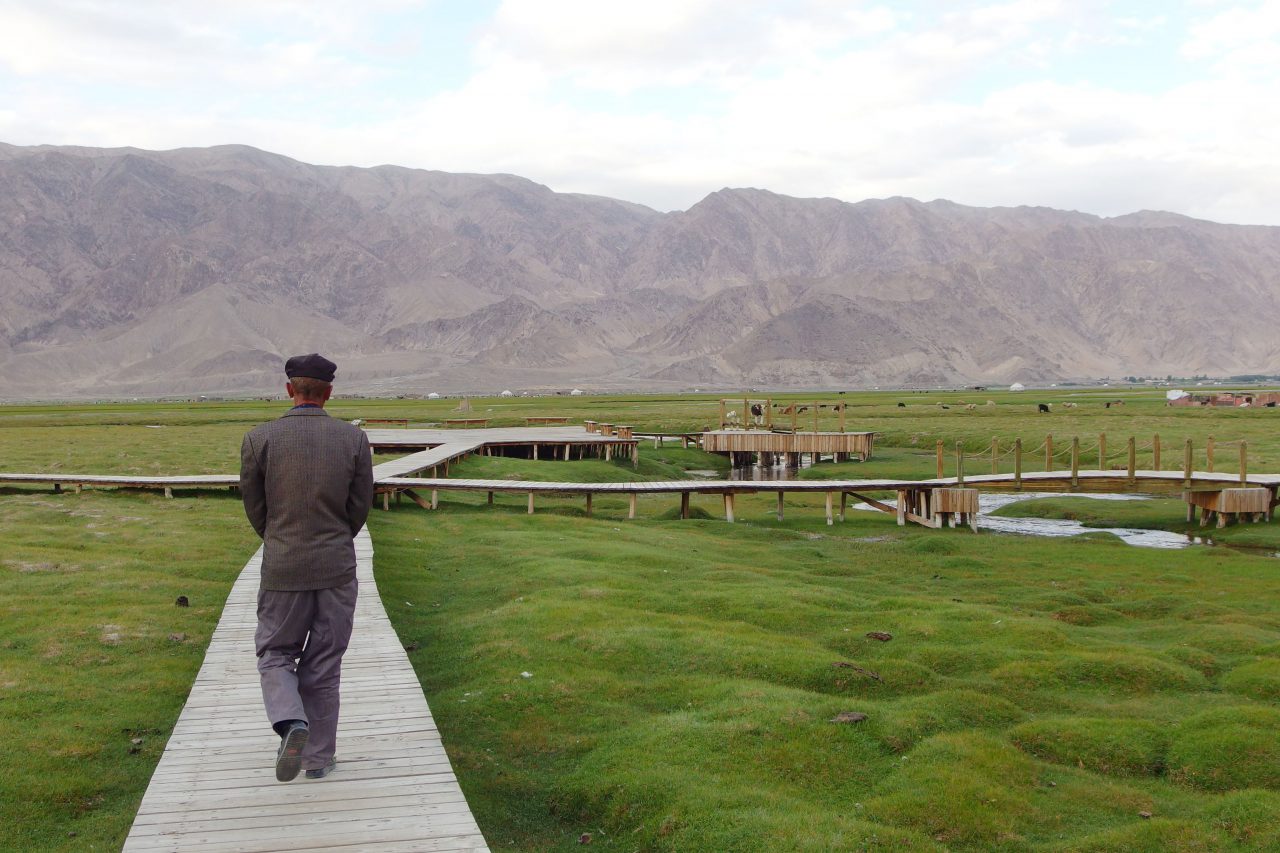
Series Traveling Asia through a Window
Memories of a Skylight: Tashqurqan Part 2
28 Jun 2017
After driving for about 7 minutes in Classy’s car, the windshield of which had a crack in it, we arrived at a wetland area that was completely different from the field of rape blossoms I mentioned before. A river cut through the center of the thick, silky fields.
A portion of it was open to tourists as a scenic area, and though I did not see anyone who appeared to be a tourist, there were walkways, rest areas, and other such things, so that it was just like Oze Hiking Route. I walked along after Classy towards the back of the wetlands.
-

Walking through the thick wetlands
After walking for a while the walkways disappeared and we started making our way directly through the fields. The river was replaced by numerous small streams that flowed through the grass. The entire wetland seemed like a massive, fluid river. In some spots I would step into what I thought was a mound of grass only to have it sink beneath the water. There were sheep and cows here and there eating grass, and it seemed to be an area where nomads lived. I learned later that the Tajiks transitioned between a nomadic lifestyle and a residential one depending on the season.
-

Sheep and cows roamed freely.
A nomad house greeted us at our destination. It was my first time seeing a Bao. (I am not sure what they are called in the local dialect, so for convenience I will refer to them with the Chinese word “Bao.”) I was surprised by the sudden unexpected appearance of a Bao.
-

A Tajik style Bao
Classy said, “This is my house too,” and two women wearing Tajik style hats emerged from the home to greet us. He said they were his family.
The Bao was a cloth tent wrapped around a thin jointed metal frame standing atop a small foundation of rocks piled on the wetland. The roof and walls were all the same thick cloth, but the bottom green edge near the foot of the structure was waterproofed with some kind of vinyl. Like a tent, the cloth roof was tied to several stakes thrust into the earth surrounding it.
-

The stone foundation and stakes secured to the cloth roof
I passed through the red entryway and went inside. There was carpet thrust between the metal frame and the outside of the tent in order to keep out the cold. I could not feel the wind at all inside. As you can tell from the floor plan about half of the inside was taken up by a bed on which you could sit and there was an ostentatious carpet laid out along with some bedrolls rolled up. I had seen a similar space buried in carpets, bedding, and cushions at Classy’s house as well. It seemed as if that kind of space was necessary for them. The rest of the inside of the tent was an earthen floor. I thought, “What a plain place. There’s really not much here,” and looked about when my gaze fell on a partition blocked by carpet that had been stood up behind which I could see luggage, stakes, and other miscellany hidden.
-

An illustration of the front of a Tajik style Bao and a floor plan of one. (Drawn by the author.)
In the center was a stove. They probably live a lot of their lives huddled about it. The women made me some chai tea then.
It was strange. This home, which was completely different from the stone one I had seen earlier was built by the same people. Like the Uyghurs of Turpan who live inside and outside depending on the season, the Tajiks live in totally different homes depending on the season.
While I drank the sweet chai tea, my eye was caught by the bright skylight in the ceiling. The chimney from the stove was sticking out through it. I thought that the skylight, which could be closed and opened with a cloth, might be the same as the one I saw in the stone house. Similar windows were present in the two completely different homes.
-

Looking up at the skylight in the Bao. You can see the chimney from the stove sticking up through it.
When I finished my chai tea, Classy took me back to my lodgings. He said, “Come to my place tomorrow morning at 9 o’clock,” before heading home.
Ryuki Taguma
Taguma was born in Shizuoka prefecture in 1992 and grew up in Tokyo. In 2014, he graduated from the Department of Architecture (Creative Science and Engineering) of Waseda University. He received a gold medal for his graduation project in architecture and received top recognition for his graduation thesis. From April 2014 he began life as a graduate student in architectural history, studying under Norihito Nakatani. In June of 2014 he proposed a restoration plan for residents of Izu Ōshima for a sediment-related disaster. This would become his graduation project. In 2015 he took a year off from school to travel around villages and folk houses in 11 countries in Asia and the Middle East, visiting countries from China to Israel. In Yilan County,Taiwan, he worked as an intern at Fieldoffice Architects.












